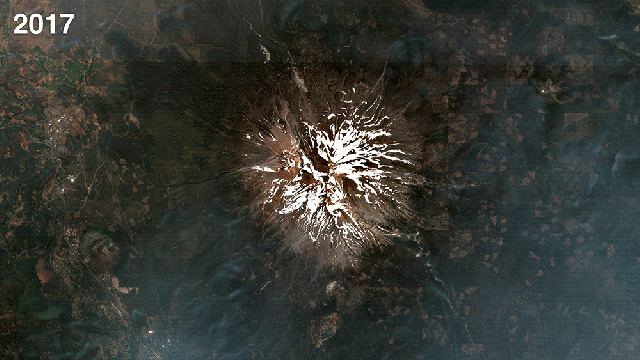The peaks of Mount Shasta are typically covered in snow year-round, but intense heat and extreme drought have rendered the mountain unrecognizable. Experts worry that glaciers on the dormant volcano are at risk of disappearing forever, should climate trends continue.
Climate change means we can’t have nice things, like snow-capped mountains in the middle of summer. Such is the case this year with Mount Shasta. The tallest peak of this dormant volcano rises 4,322 metres above the scenic northern California landscape, making it among the tallest mountains in the contiguous U.S. Shasta’s peaks will often remain white from January through to December, and during years when the snow does melt, it doesn’t happen until late summer or early fall. This year, however, the peaks lost their white caps in July and August, as the Washington Post reports.
“This summer is different,” explained Mount Shasta Ski Park on its Facebook page. “This past winter we got 50% of our typical snowpack. The snow stuck around later in the trees where it is protected from sun and wind. The snow that fell on the mountain that was not protected from the wind and the sun, was blown right off the mountain. Then as summer came around, there wasn’t much snow, and the sun/heat took care of the rest.”

The ingredients for this unusual absence of snow are a full cup of unusual warmth, a heaping portion of extreme drought, and a splash of incessant heat waves. Such was the unsavoury meal served to the Pacific Northwest this past summer, including an unprecedented heat wave that struck the region in June. Temperatures remained hot throughout the entire summer, with California as a whole experiencing its warmest summer on record.
Earlier this summer, Mount Shasta recorded multiple daily records for heat at both mid and high elevations, including two days of 39.4 degrees C temperatures at 1,067 metres, according to the Washington Post. At 2,316 metres, it wasn’t unusual to experience temperatures between 25 and 29 degrees Celsius.
I don’t need to tell you what happens when snow is exposed to those kinds of temperatures. Mauri Pelto, a glaciologist at Nichols College and an expert on climate change, said Mount Shasta experienced a “spectacular loss of snowpack” above 3,658 metres,, as he told mtshasta news.
The problem with the absence of snow, aside from the aesthetic loss, is that it removes a protective layer that prevents the melting of glaciers, of which there are seven on the mountain. The largest of these is Whitney glacier (and the largest in all of California), which has retreated by 800 metres, or roughly a quarter of its length, in the past 16 years.
“The glaciers that are visible from the north side of the mountain are melting VERY quickly this year,” Mount Shasta Ski Park said. “This has caused lahars (mudflows) down the mountain — taking out roads and bridges. The effects of climate change are visible.”
This year alone, Whitney Glacier lost 20% of its total volume, and it’s now splitting into two distinct glaciers, as WaPo reports. Of the 4.6 square kilometres of glacial ice present on the mountain at the turn of the century, roughly half is already gone, according to Pelto, who worries that the glaciers won’t be able to recover.
That said, the potential for increased precipitation in the region is a “wild card,” as geologist Nick Caselli told mtshasta news. The mountain’s “glaciers pulse and shrink rapidly with wet or dry years,” he said. El Niño, which provides California with excess amounts of water and snow, “is driven by heat in the ocean” and it’s “not impossible” that, as temperatures increase, northern California “could get wetter.”
So yeah, it’s complicated, and only time will tell if Mount Shasta will hold on to its picturesque glaciers. As an aside, Mount Shasta is ranked among the top five most dangerous volcanoes in the United States. It may be dormant, but it’s not extinct.
